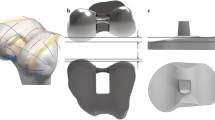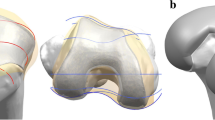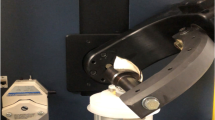Abstract
Although the conventional total knee arthoplasty (TKA) planning used 2D or 3D images of the patient’s lower extremity to determine bone alignment, it was shown that good bone alignment does not always guarantee successful results due to unbalanced joint contact forces and soft tissue tension. Thus, the joint contact force balance and soft tissue tension were pre-operatively calculated using finite element analysis (FEA). Although the results of FEA are accurate, the rigid body spring method (RBSM) has introduced for the joint contact force or pressure distribution due to the high costs for FEA. In this paper, an innovative method was described to quantify the pre- and post-operative knee contact force balance using various engineering techniques, including the free-form deformation (FFD) technique, and RBSM-based cartilage contact force and ligament tension estimation algorithm. Nine cases of TKA planning were performed with three different surgical options, including over-correction of the valgus ratio of the femur, tibial plateau cutting length, and MCL release to redistribute the medial and lateral contact force balance. This method is useful as a patient-specific preoperative planning tool in TKA surgery.
Similar content being viewed by others
References
Bargar, W. L., Bauer, A., and Börner, M., “Primary and Revision Total Hip Replacement Using the ROBODOC(R) System,” Clin. Orthop. Relat. Res., No.354, pp. 82–91, 1998.
Pearle, A. D., O’Loughlin, P. F., and Kendoff, D. O., “Robot-Assisted Unicompartmental Knee Arthroplasty,” The Journal of Arthroplasty, Vol. 25, No. 2, pp. 230–237, 2010.
Kim, Y. H. and Minh, H. L., “A Laboratory-Level Surgical Robot System for Minimal Invasive Surgery (MIS) Total Knee Arthroplasty,” Int. J. Prec. Eng. Manuf., Vol. 12, No. 2, pp. 237–242, 2011.
Anderson, K. C., Buehler, K. C., and Markel, D. C., “Computer Assisted Navigation in Total Knee Arthroplasty: Comparison with Conventional Methods,” The Journal of Arthroplasty, Vol. 20, Supplement 3, pp. 132–138, 2005.
Sparmann, M., Wolke, B., Czupalla, H., Banzer, D., and Zink, A., “Positioning of Total Knee Arthroplasty with and without Navigation Support: A Prospective, Randomised Study,” Journal of Bone & Joint Surgery, British Volume, Vol. 85, No. 6, pp. 830–835, 2003.
Sugano, N., “Computer-Assisted Orthopedic Surgery,” Journal of Orthopaedic Science, Vol. 8, No. 3, pp. 442–448, 2003.
Stulberg, S. D., Picard, F., and Saragaglia, D., “Computer-Assisted Total Knee Replacement Arthroplasty,” Operative Techniques in Orthopaedics, Vol. 10, No. 1, pp. 25–39, 2000.
Böhling, U., Schamberger, H., Grittner, U., and Scholz, J., “Computerised and Technical Navigation in Total Knee-Arthroplasty,” Journal of Orthopaedics and Traumatology, Vol. 6, No. 2, pp. 69–75, 2005.
Matsumoto, T., Muratsu, H., Tsumura, N., Mizuno, K., Kurosaka, M., and Kuroda, R., “Soft Tissue Balance Measurement in Posterior-Stabilized Total Knee Arthroplasty with a Navigation System,” The Journal of arthroplasty, Vol. 24, No. 3, pp. 358–364, 2009.
Matsumoto, T., Mizuno, K., Muratsu, H., Tsumura, N., Fukase, N., and et al., “Influence of Intra-Operative Joint Gap on Post-Operative Flexion Angle on Osteoarthritis Patients Undergoing Posterior-Stabilized Total Knee Arthroplasty,” Knee Surgery, Sports Traumatology, Arthroscopy, Vol. 15, No. 8, pp. 1013–1018, 2007.
Asano, H., Muneta, T., and Sekiya, I., “Soft Tissue Tension in Extension in Total Knee Arthroplasty Affects Postoperative Knee Extension and Stability,” Knee Surgery, Sports Traumatology, Arthroscopy, Vol. 16, No. 11, pp. 999–1003, 2008.
Kluge, W. H., “Computer-assisted Knee Replacement Techniques,” Curr. Orthop., Vol. 21, No. 3, pp. 200–206, 2007.
Marcacci, M., Nofrini, L., Iacono, F., Di Martino, A., Bignozzi, S., and Lo Presti, M., “A Novel Computer-Assisted Surgical Technique for Revision Total Knee Arthroplasty,” Computers in Biology and Medicine, Vol. 37, No. 12, pp. 1771–1779, 2007.
Stulberg, S. D., Loan, P., and Sarin, V., “Computer-Assisted Navigation in Total Knee Replacement: Results of an Initial Experience in Thirty-Five Patients,” The Journal of Bone & Joint Surgery, Vol. 84, Supplement. 2, pp. 90–98, 2002.
Wasielewski, R. C., Galat, D. D., and Komistek, R. D., “Correlation of Compartment Pressure Data from an Intraoperative Sensing Device with Postoperative Fluoroscopic Kinematic Results in TKA Patients,” Journal of Biomechanics, Vol. 38, No. 2, pp. 333–339, 2005.
Bellemans, J., Vandenneucker, H., Vanlauwe, J., and Victor, J., “The Influence of Coronal Plane Deformity on Mediolateral Ligament Status: An Observational Study in Varus Knees,” Knee Surgery, Sports Traumatology, Arthroscopy, Vol. 18, No. 2, pp. 152–156, 2010.
Oh, K. J., Park, W. M., Kim, K., and Kim, Y. H., “Quantification of Soft Tissue Balance in Total Knee Arthroplasty using Finite Element Analysis,” Computer Methods in Biomechanics and Biomedical Engineering, pp. 1–5, 2013.
Takahashi, T., Wada, Y., and Yamamoto, H., “Soft-Tissue Balancing with Pressure Distribution During Total Knee Arthroplasty,” Journal of Bone & Joint Surgery, British Volume, Vol. 79, No. 2, pp. 235–239, 1997.
Mihalko, W. M., Saleh, K. J., Krackow, K. A., and Whiteside, L. A., “Soft-Tissue Balancing during Total Knee Arthroplasty in The Varus Knee,” Journal of the American Academy of Orthopaedic Surgeons, Vol. 17, No. 12, pp. 766–774, 2009.
Haut Donahue, T. L., Hull, M. L., Rashid, M. M., and Jacobs, C. R., “A Finite Element Model of the Human Knee Joint for the Study of Tibio-Femoral Contact,” Journal of Biomechanical Engineering, Vol. 124, No. 3, pp. 273–280, 2002.
Bendjaballah, M. Z., Shirazi-Adl, A., and Zukor, D. J., “Biomechanics of the Human Knee Joint in Compression: Reconstruction, Mesh Generation and Finite Element Analysis,” The Knee, Vol. 2, No. 2, pp. 69–79, 1995.
Halloran, J. P., Petrella, A. J., and Rullkoetter, P. J., “Explicit Finite Element Modeling of Total Knee Replacement Mechanics,” Journal of Biomechanics, Vol. 38, No. 2, pp. 323–331, 2005.
Sint Jan, S. V., Sobzack, S., Dugailly, P. M., Feipel, V., Lefèvre, P., and et al., “Low-Dose Computed Tomography: A Solution for in Vivo Medical Imaging and Accurate Patient-Specific 3D Bone Modeling,” Clinical Biomechanics, Vol. 21, No. 9, pp. 992–998, 2006.
Frush, D. P., Donnelly, L. F., and Rosen, N. S., “Computed Tomography and Radiation Risks: What Pediatric Health Care Providers Should Know,” Pediatrics, Vol. 112, No. 4, pp. 951–957, 2003.
Chao, E. and Sim, F. H., “Computer-Aided Preoperative Planning in Knee Osteotomy,” The Iowa Orthopaedic Journal, Vol. 15, No. pp. 4–18, 1995.
Iglič, A., Kralj-Iglič, V., Daniel, M., and Maček-Lebar, A., “Computer Determination of Contact Stress Distribution and Size of Weight Bearing Area in the Human Hip Joint,” Computer Methods in Biomechanics & Biomedical Engineering, Vol. 5, No. 2, pp. 185–192, 200
Moon, Y. W., Kim, J. G., Han, J. H., Do, K. H., Seo, J. G., and Lim, H. C., “Factors Correlated with the Reducibility of Varus Deformity in Knee Osteoarthritis: An Analysis Using Navigation Guided TKA,” Clinics in Orthopedic Surgery, Vol. 5, No. 1, pp. 36–43, 2013.
Anderson, D. D., Iyer, K. S., Segal, N. A., Lynch, J. A., and Brown, T. D., “Implementation of Discrete Element Analysis for Subject-Specific, Population-Wide Investigations of Habitual Contact Stress Exposure,” Journal of Applied Biomechanics, Vol. 26, No. 2, pp. 215–223, 2010.
Genda, E., Iwasaki, N., Li, G., MacWilliams, B. A., Barrance, P. J., and Chao, E., “Normal Hip Joint Contact Pressure Distribution in Single-Leg Standing-Effect of Gender and Anatomic Parameters,” Journal of Biomechanics, Vol. 34, No. 7, pp. 895–905, 2001.
Elias, J. J., Wilson, D. R., Adamson, R., and Cosgarea, A. J., “Evaluation of a Computational Model used to Predict the Patellofemoral Contact Pressure Distribution,” Journal of Biomechanics, Vol. 37, No. 3, pp. 295–302, 2004.
Laporte, S., Skalli, W., De Guise, J., Lavaste, F., and Mitton, D., “A Biplanar Reconstruction Method Based on 2D and 3D Contours: Application to the Distal Femur,” Computer Methods in Biomechanics & Biomedical Engineering, Vol. 6, No. 1, pp. 1–6, 2003.
Mitton, D., Deschenes, S., Laporte, S., Godbout, B., Bertrand, S., and et al., “3D Reconstruction of the Pelvis from Bi-Planar Radiography,” Computer Methods in Biomechanics and Biomedical Engineering, Vol. 9, No. 1, pp. 1–5, 2006.
Koh, K., Kim, Y. H., Kim, K., and Park, W. M., “Reconstruction of Patient-Specific Femurs using X-Ray and Sparse CT Images,” Computers in Biology and Medicine, Vol. 41, No. 7, pp. 421–426, 2011.
Li, G., Sakamoto, M., and Chao, E., “A Comparison of Different Methods Inpredicting Static Pressure Distribution in Articulating Joints,” Journal of Biomechanics, Vol. 30, No. 6, pp. 635–638, 1997.
Hsu, R. W. W., Himeno, S., Coventry., M. B., and Chao, E. Y. S., “Normal Axial Alignment of the Lower Extremity and Load-bearing Distribution at The Knee,” The Journal of Clin. Orthop. Relat. Res., No. 255, pp. 215–227, 1990.
Nuño, N. and Ahmed, A. M., “Sagittal Profile of the Femoral Condyles and Its Application to Femorotibial Contact Analysis,” Journal of Biomechanical Engineering, Vol. 123, No. 1, pp. 18–26, 2000.
Blankevoort, L., Kuiper, J., Huiskes, R., and Grootenboer, H., “Articular Contact in A Three Dimensional Model of The Knee,” Journal of Biomechanics, Vol. 24, No. 11, pp. 1019–1031, 1991.
Blankevoort, L. and Huiskes, R., “Ligament-bone Interaction in Three-Dimensional Model of The Knee,” J Biomech Eng, Vol. 113, No. 3, pp. 263–269, 1991.
Li, G., Park, S. E., DeFrate, L. E., Schutzer, M. E., Ji, L., and et al., “The Cartilage Thickness Distribution in The Tibiofemoral Joint and Its Correlation with Cartilage To Cartilage Contact,” Clinical Biomechanics, Vol. 20, No. 7, pp. 736–744, 2005.
LaPrade, R. F., Engebretsen, A. H., Ly, T.V., Johansen, S., Wentorf, F. A., and Engebretsen, L., “The Anatomy of the Medial Part of the Knee,” The Journal of Bone & Joint Surgery, Vol. 89, No. 9, pp. 2000–2010, 2007.
Li, G., Sakamoto, M., and Chao, E., “A Comparison of Different Methods In predicting Static Pressure Distribution in Articulating Joints,” Journal of Biomechanics, Vol. 30, No. 6, pp. 635–638, 1997.
Hull, M., Donahue, T., Rashid, M., and Jacobs, C., “A Finite Element Model of the Human Knee Joint for the Study of Tibio-Femoral Contact,” J Biomech Eng, Vol. 124, No. 3, pp. 273–280, 2002.
Moglo, K. E. and Shirazi-Adl, A., “On the Coupling between Anterior and Posterior Cruciate Ligaments, and Knee Joint Response under Anterior Femoral Drawer in Flexion: A Finite Element Study,” Clinical Biomechanics, Vol. 18, No. 8, pp. 751–759, 2003.
Peña, E., Calvo, B., Martínez, M. A., and Doblaré, M., “A Threedimensional Finite Element Analysis of the Combined Behavior of Ligaments and Menisci in the Healthy Human Knee Joint,” Journal of Biomechanics, Vol. 39, No. 9, pp. 1686–1701, 2006.
Li, G., Lopez, O., and Rubash, H., “Variability of a Three-Dimensional Finite Element Model Constructed Using Magnetic Resonance Images of a Knee for Joint Contact Stress Analysis,” Journal of Biomechanical Engineering, Vol. 123, No. 4, pp. 341–346, 2001.
Author information
Authors and Affiliations
Corresponding author
Rights and permissions
About this article
Cite this article
Minh, H.L., Park, W.M., Kim, K. et al. A new patient-specific planning method based on joint contact force balance with soft tissue release in total knee arthroplasty. Int. J. Precis. Eng. Manuf. 14, 2193–2199 (2013). https://doi.org/10.1007/s12541-013-0297-2
Received:
Accepted:
Published:
Issue Date:
DOI: https://doi.org/10.1007/s12541-013-0297-2




